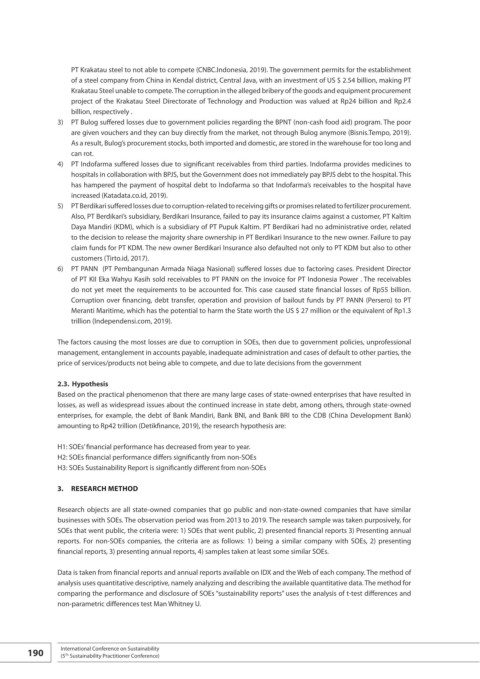Page 191 - SUSTAINABILITY ISSUES & COVID-19
P. 191
PT Krakatau steel to not able to compete (CNBC.Indonesia, 2019). The government permits for the establishment
of a steel company from China in Kendal district, Central Java, with an investment of US $ 2.54 billion, making PT
Krakatau Steel unable to compete. The corruption in the alleged bribery of the goods and equipment procurement
project of the Krakatau Steel Directorate of Technology and Production was valued at Rp24 billion and Rp2.4
billion, respectively .
3) PT Bulog suffered losses due to government policies regarding the BPNT (non-cash food aid) program. The poor
are given vouchers and they can buy directly from the market, not through Bulog anymore (Bisnis.Tempo, 2019).
As a result, Bulog’s procurement stocks, both imported and domestic, are stored in the warehouse for too long and
can rot.
4) PT Indofarma suffered losses due to significant receivables from third parties. Indofarma provides medicines to
hospitals in collaboration with BPJS, but the Government does not immediately pay BPJS debt to the hospital. This
has hampered the payment of hospital debt to Indofarma so that Indofarma’s receivables to the hospital have
increased (Katadata.co.id, 2019).
5) PT Berdikari suffered losses due to corruption-related to receiving gifts or promises related to fertilizer procurement.
Also, PT Berdikari’s subsidiary, Berdikari Insurance, failed to pay its insurance claims against a customer, PT Kaltim
Daya Mandiri (KDM), which is a subsidiary of PT Pupuk Kaltim. PT Berdikari had no administrative order, related
to the decision to release the majority share ownership in PT Berdikari Insurance to the new owner. Failure to pay
claim funds for PT KDM. The new owner Berdikari Insurance also defaulted not only to PT KDM but also to other
customers (Tirto.id, 2017).
6) PT PANN (PT Pembangunan Armada Niaga Nasional) suffered losses due to factoring cases. President Director
of PT KII Eka Wahyu Kasih sold receivables to PT PANN on the invoice for PT Indonesia Power . The receivables
do not yet meet the requirements to be accounted for. This case caused state financial losses of Rp55 billion.
Corruption over financing, debt transfer, operation and provision of bailout funds by PT PANN (Persero) to PT
Meranti Maritime, which has the potential to harm the State worth the US $ 27 million or the equivalent of Rp1.3
trillion (Independensi.com, 2019).
The factors causing the most losses are due to corruption in SOEs, then due to government policies, unprofessional
management, entanglement in accounts payable, inadequate administration and cases of default to other parties, the
price of services/products not being able to compete, and due to late decisions from the government
2.3. Hypothesis
Based on the practical phenomenon that there are many large cases of state-owned enterprises that have resulted in
losses, as well as widespread issues about the continued increase in state debt, among others, through state-owned
enterprises, for example, the debt of Bank Mandiri, Bank BNI, and Bank BRI to the CDB (China Development Bank)
amounting to Rp42 trillion (Detikfinance, 2019), the research hypothesis are:
H1: SOEs’ financial performance has decreased from year to year.
H2: SOEs financial performance differs significantly from non-SOEs
H3: SOEs Sustainability Report is significantly different from non-SOEs
3. RESEARCH METHOD
Research objects are all state-owned companies that go public and non-state-owned companies that have similar
businesses with SOEs. The observation period was from 2013 to 2019. The research sample was taken purposively, for
SOEs that went public, the criteria were: 1) SOEs that went public, 2) presented financial reports 3) Presenting annual
reports. For non-SOEs companies, the criteria are as follows: 1) being a similar company with SOEs, 2) presenting
financial reports, 3) presenting annual reports, 4) samples taken at least some similar SOEs.
Data is taken from financial reports and annual reports available on IDX and the Web of each company. The method of
analysis uses quantitative descriptive, namely analyzing and describing the available quantitative data. The method for
comparing the performance and disclosure of SOEs “sustainability reports” uses the analysis of t-test differences and
non-parametric differences test Man Whitney U.
190 International Conference on Sustainability
(5 Sustainability Practitioner Conference)
Th

